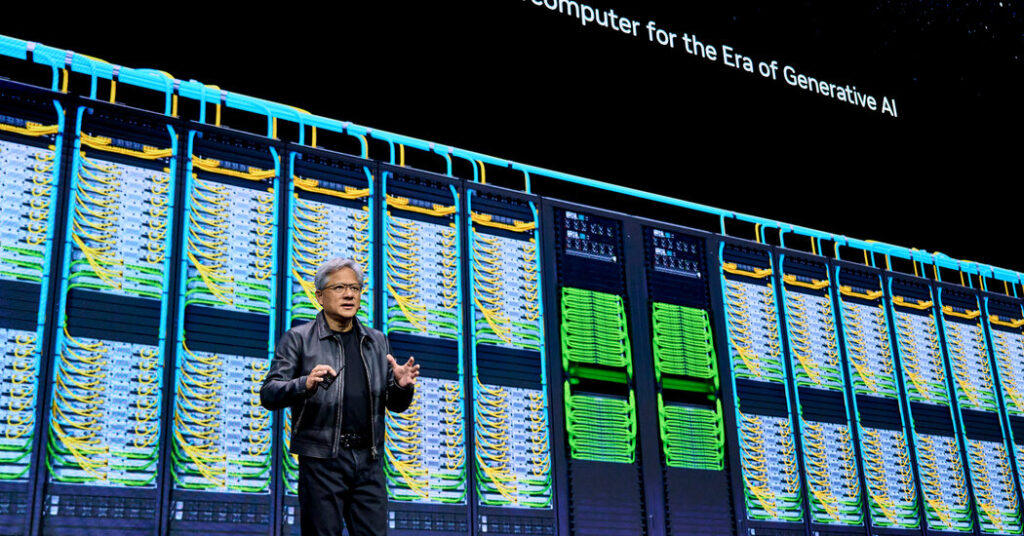[ad_1]
Nvidia, the kingpin of chips powering artificial intelligence, on Wednesday released quarterly financial results that reinforced how the company has become one of the biggest winners of the artificial intelligence boom, and it said demand for its products would fuel continued sales growth.
The Silicon Valley chip maker has been on an extraordinary rise over the past 18 months, driven by demand for its specialized and costly semiconductors, which are used for training popular A.I. services like OpenAI’s ChatGPT chatbot. Nvidia has become known as one of the “Magnificent Seven” tech stocks, which along with others like Amazon, Apple and Microsoft have helped power the stock market.
Nvidia’s valuation has surged more than 40 percent to $1.7 trillion since the start of the year, turning it into one of the world’s most valuable public companies. Last week, the company briefly eclipsed the market values of Amazon and Alphabet before receding to the fifth-most-valuable tech company. Its stock market gains are largely a result of repeatedly exceeding analysts’ expectations for growth, a feat that is becoming more difficult as they keep raising their predictions.
On Wednesday, Nvidia reported that revenue in its fiscal fourth quarter more than tripled from a year earlier to $22.1 billion, while profit soared nearly ninefold to $12.3 billion. Revenue was well above the $20 billion the company predicted in November and above Wall Street estimates of $20.4 billion.
Nvidia predicted that revenue in the current quarter would total about $24 billion, also more than triple the year-earlier period and higher than analysts’ average forecast of $22 billion.
Jensen Huang, Nvidia’s co-founder and chief executive, argues that an epochal shift to upgrade data centers with chips needed for training powerful A.I. models is still in its early phases. That will require spending roughly $2 trillion to equip all the buildings and computers to use chips like Nvidia’s, he predicts.
“Accelerated computing and generative A.I. have hit the tipping point,” Mr. Huang said in a news release. “Demand is surging worldwide across companies, industries and nations.”
Some analysts had predicted a sell-off after the Nvidia announcement, a reaction to just how high its share price has risen. But shares increased more than 9 percent in after-hours trading.
“Despite concerns over its high valuation, Nvidia’s unparalleled A.I.-related intellectual property, rooted in decades of visionary investment, sets it apart in a league of its own,” wrote Hans Mosesmann, an analyst at Rosenblatt Securities, in a research report before the company reported.
One factor driving Nvidia’s latest revenue growth is the ability of the company’s production partners, led by Taiwan Semiconductor Manufacturing Company, to boost supplies of Nvidia’s flagship A.I. chip, which commands prices ranging from $15,000 to $40,000.
Mr. Huang said on a conference call with analysts on Wednesday that the availability of those chips had improved significantly, but noted that the company would soon introduce new products that would again be scarce.
“Whenever we have new products, it ramps from zero to a very large number, and you can’t do that overnight,” he said during the call.
But giant cloud computing companies like Amazon, Google and Microsoft are designing their own A.I. chips to use in addition to Nvidia’s, and rival chipmakers keep introducing their own A.I. products.
Intel, which has long dominated the standard microprocessor chip industry but lags in A.I., marshaled an array of partners and potential customers in Silicon Valley on Wednesday to discuss its plans to offer manufacturing services, which could boost industry capacity to build A.I. chips. Attendees included Sam Altman, who relies heavily on Nvidia chips as OpenAI’s chief executive.
“Intel was the evil Borg of the industry at one time,” said Daniel Newman, chief executive of Futurum Research, which tracks the semiconductor industry. Now, he said, “companies are kind of coming together to make sure Nvidia doesn’t get too much more powerful.”
The Biden administration has raised another set of hurdles for Nvidia and other U.S. chip manufacturers, placing restrictions on their chip sales in China. Nvidia has responded by selling less-powerful versions of some products in the market.
Still, the company said Wednesday that its sales to China had dropped to a mid-single-digit percentage of its data center chip revenues, from 19 percent in its 2023 fiscal year.
Meanwhile, some experts worry that a global rollout of the company’s pricey, power-hungry chips will overtax countries’ power grids and budgets.
Mr. Huang addressed some of those concerns in February at the World Governments Summit in Dubai. He said that Nvidia’s chips were cheap and efficient compared with using slower standard microprocessors to get the same work done — and that much faster chips were on the way, some of which the company is expected to unveil in March.
“If you assume that computers never get any faster, you might come to the conclusion we need 14 different planets and three different galaxies and four more suns to fuel all this,” Mr. Huang said. “But obviously computer architecture continues to advance.”
[ad_2]
Source link

